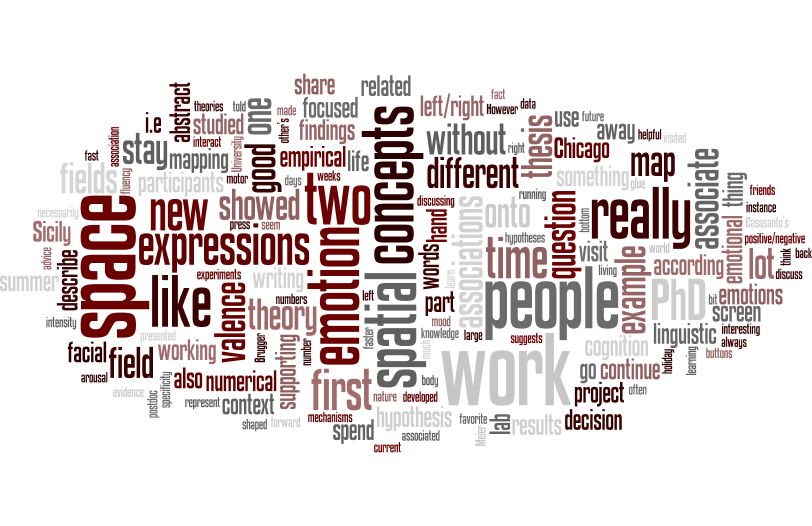Katia Carbè, from the Action Bias & Control Group led by Prof. dr. Wim Gevers , successfully defended her PhD thesis titled: “Spatial coding of abstract concepts” on October 28th. External jury members included Prof. dr. Bert Reynvoet (KUL, Belgium) and Prof. dr. Christine Schiltz (Université du Luxembourg). Afterwards, Katia answered a few questions about her thesis and PhD life in this short interview.
Could you briefly describe the topic of your thesis?
I will start with the field. So the fields that I work in are numerical cognition on the one hand and emotion on the other. These are two fields that seem completely unrelated to each other but apparently spatial relations can be the glue that connects these two different fields. And this is what I studied in my thesis. So I studied the spatial mechanisms underlying the spatial association between abstract concepts and left/right responses. The question was how people map abstract concepts onto space and how these concepts are related to numerical cognition, like numbers and magnitude concepts, and also other kinds of concepts related to emotional valence. There are two competing hypotheses about the origin and the nature of this mapping: (1) the mental number line hypothesis and (2) the decision account. A large part of my work was aimed at finding out which of these theories is supported more by existing findings and my own experimental work.

Do you want to continue working in this field?
Of course I would love to, because I was fascinated by the fact that we map emotion onto space. It’s something that sounds a bit weird, but in the scientific community it’s largely accepted that we associate emotion with space. For example, in our linguistic expressions, ‘good’ is often associated with ‘up’ and ‘bad’ with ‘down’. So when we say something like “I’m so tired” our shoulders and arms hang down, so we use these associations in our behaviour without realising it. So without necessarily intending it, we already use space to express our mood for instance. This is the conceptual metaphor theory, from Lakoff and Johnson, but this was just theoretical work without empirical work supporting it. This theory has been developed back in the 1980’s but it is only in 2004 that Meier and Robinson provided empirical evidence supporting this account. They showed that people react faster to positive words presented at the top of the screen and to negative words displayed at the bottom of the screen. Later, Casasanto showed that people map valence onto space according to motor fluency instead of linguistic expressions. His body specificity hypothesis suggests indeed that people associate ‘good’ with the part of the space (i.e. left/right), with which they interact more fluently with their dominant hand. I would like to continue to work on these findings.
Is the spatial mapping of emotion an innate mechanism or are these associations culturally determined?
I think of it more as an online process, so it is not a question of what comes first. However, the associations between spatial representation and emotions are shaped by the context. So it is your decision that specifies the way you represent emotions. For example, in one of our experiments we used different intensities of emotional facial expressions and participants had to press lateralized buttons whether the facial expressions were positive/negative or less/more intense. We showed that participants explicitly associate emotion with space according to context, regardless of valence or intensity (i.e. arousal).
What was the first thing you did right after your PhD defense?
The first thing was plan a holiday! I’m planning to go to South Africa for ten days and after that I will spend two weeks in Sicily. I didn’t really have a summer vacation because I spend all my time writing my thesis this summer. But actually, I still have to work, because I’m writing a postdoc project with a collaborator from the University of Zurich, so I will first go there to visit Prof. dr. Peter Brugger. We’re both really excited about the project so I’m looking forward to that.
So how would you describe your PhD life?
It has been four years, but it feels like time has flown away. I was so focused on working and living my life here that I didn’t realise how fast time was running away. But I did a lot of things, I met a lot of interesting people, made new friends, I even had to learn two new languages. And another awesome PhD experience was my visit in Chicago! I visited Casasanto’s lab and it was a really, really good time. People there were very helpful with learning to program, improving my English, and by sharing and discussing their results with me. I liked my stay there so much because the people in his lab felt like a family to me. I was so proud that when I left they told me that they learned a lot from me. And it was the same for me. It was really a wonderful stay. It’s my favorite city in the world. Sicily is my homeland but Chicago is my second one.
As a last question, what would you say to future or current PhD students?
My advice would be to always stay focused on what is the latest in your field, for example new analysis techniques and new designs. And also to talk to others about your data and share your results and discuss different interpretations. That’s very important, to share each other’s knowledge.
Interview by Dalila Achoui.

